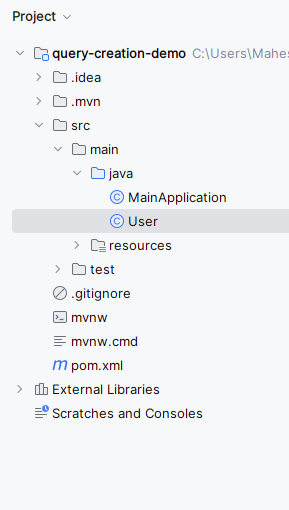JPA – Query Creation from Method Names
Last Updated :
05 Apr, 2024
In Java, JPA can defined as Java Persistence API can provide a powerful way to interact with databases in Java applications. One of the key features of the JPA is the Query Creation from the Method names and it allows the developers to dynamically create the database queries based on the method names.
Creating Queries from Method Names in JPA
Query Creation from the Method Names is a feature provided by the frameworks like the Spring Data JPA but it can also be implemented directly with the JPA. It can involve defining the repository methods in such a way that the framework automatically generates the corresponding JPQL queries on method names.
Steps to Implement the Query Creation from Method Names:
- Define the Entity: Create the Entity class that represents the entity with the JPA annotations.
- Configure the Persistence: Then we will set up the persistence configuration in the persistence.xml of the JPA project.
- Query Creation from the Method Names: Here, we create the queries that can declare the methods in the main application following the specific naming conventions of the project.
- Invoke the Query creations: Then we call the methods of the query creation in the application code to perform the database operations.
Step-by-Step Implementation of JPA Query Creation from Method Names
We can develop a simple JPA application that can demonstrate the Query Creation from the Method Names of the application.
Step 1: Create the new JPA project using the IntelliJ Idea named query-creation-demo. After creating the project, the file structure looks like the below image.

Step 2: Open the open.xml and add the below dependencies into the project.
<dependency>
<groupId>org.hibernate.orm</groupId>
<artifactId>hibernate-core</artifactId>
<version>6.0.2.Final</version>
</dependency>
<dependency>
<groupId>org.glassfish.jaxb</groupId>
<artifactId>jaxb-runtime</artifactId>
<version>3.0.2</version>
</dependency>
<dependency>
<groupId>org.junit.jupiter</groupId>
<artifactId>junit-jupiter-api</artifactId>
<version>${junit.version}</version>
<scope>test</scope>
</dependency>
<dependency>
<groupId>org.junit.jupiter</groupId>
<artifactId>junit-jupiter-engine</artifactId>
<version>${junit.version}</version>
<scope>test</scope>
</dependency>
<dependency>
<groupId>mysql</groupId>
<artifactId>mysql-connector-java</artifactId>
<version>8.0.28</version>
</dependency>
Step 3: Open the persistence.xml and put the below code into the project and it can configure the database of the project.
XML
<?xml version="1.0" encoding="UTF-8" standalone="yes"?>
<persistence xmlns="https://jakarta.ee/xml/ns/persistence"
xmlns:xsi="http://www.w3.org/2001/XMLSchema-instance"
xsi:schemaLocation="https://jakarta.ee/xml/ns/persistence https://jakarta.ee/xml/ns/persistence/persistence_3_0.xsd"
version="3.0">
<persistence-unit name="examplePU">
<class>User</class>
<properties>
<property name="javax.persistence.jdbc.url" value="jdbc:mysql://localhost:3306/example"/>
<property name="javax.persistence.jdbc.user" value="root"/>
<property name="javax.persistence.jdbc.password" value=""/>
<property name="javax.persistence.jdbc.driver" value="com.mysql.jdbc.Driver"/>
<property name="hibernate.dialect" value="org.hibernate.dialect.MySQL5Dialect"/>
<property name="hibernate.hbm2ddl.auto" value="update"/>
</properties>
</persistence-unit>
</persistence>
Step 4: Create the new Entity Java class named as User.
Go to src > main > java > User and put the below code.
Java
import jakarta.persistence.Entity;
import jakarta.persistence.GeneratedValue;
import jakarta.persistence.GenerationType;
import jakarta.persistence.Id;
@Entity
public class User {
@Id
@GeneratedValue(strategy = GenerationType.IDENTITY)
private Long id;
private String username;
private String email;
// Constructors, getters, and setters
public User() {}
public User(String username, String email) {
this.username = username;
this.email = email;
}
public Long getId() {
return id;
}
public void setId(Long id) {
this.id = id;
}
public String getUsername() {
return username;
}
public void setUsername(String username) {
this.username = username;
}
public String getEmail() {
return email;
}
public void setEmail(String email) {
this.email = email;
}
@Override
public String toString() {
return "User{" +
"id=" + id +
", username='" + username + '\'' +
", email='" + email + '\'' +
'}';
}
}
Step 5: Create the new Entity Java class named as MainApplication.
Go to src > main > java > MainApplication and put the below code.
Java
import jakarta.persistence.EntityManager;
import jakarta.persistence.EntityManagerFactory;
import jakarta.persistence.Persistence;
import jakarta.persistence.TypedQuery;
import java.util.List;
public class MainApplication {
public static void main(String[] args) {
EntityManagerFactory emf = Persistence.createEntityManagerFactory("examplePU");
EntityManager em = emf.createEntityManager();
// Create and persist some users
em.getTransaction().begin();
User user1 = new User("Raju", "rajukumar@example.com");
User user2 = new User("Eswar", "eswar@example.com");
em.persist(user1);
em.persist(user2);
em.getTransaction().commit();
// Query users by username
em.getTransaction().begin();
TypedQuery<User> queryByUsername = em.createQuery("SELECT u FROM User u WHERE u.username = :username", User.class)
.setParameter("username", "JohnDoe");
List<User> usersByUsername = queryByUsername.getResultList();
if (!usersByUsername.isEmpty()) {
for (User user : usersByUsername) {
System.out.println("User found by username: " + user);
}
} else {
System.out.println("No user found with the specified username.");
}
// Query users by email domain
TypedQuery<User> queryByEmail = em.createQuery("SELECT u FROM User u WHERE u.email LIKE :domain", User.class)
.setParameter("domain", "%example.com");
List<User> usersByEmail = queryByEmail.getResultList();
if (!usersByEmail.isEmpty()) {
for (User user : usersByEmail) {
System.out.println("User found by email domain: " + user);
}
} else {
System.out.println("No user found with the specified email domain.");
}
em.getTransaction().commit();
em.close();
emf.close();
}
}
pom.xml:
XML
<?xml version="1.0" encoding="UTF-8"?>
<project xmlns="http://maven.apache.org/POM/4.0.0"
xmlns:xsi="http://www.w3.org/2001/XMLSchema-instance"
xsi:schemaLocation="http://maven.apache.org/POM/4.0.0 https://maven.apache.org/xsd/maven-4.0.0.xsd">
<modelVersion>4.0.0</modelVersion>
<groupId>org.example</groupId>
<artifactId>query-creation-demo</artifactId>
<version>1.0-SNAPSHOT</version>
<name>query-creation-demo</name>
<properties>
<project.build.sourceEncoding>UTF-8</project.build.sourceEncoding>
<maven.compiler.target>11</maven.compiler.target>
<maven.compiler.source>11</maven.compiler.source>
<junit.version>5.9.2</junit.version>
</properties>
<dependencies>
<dependency>
<groupId>org.hibernate.orm</groupId>
<artifactId>hibernate-core</artifactId>
<version>6.0.2.Final</version>
</dependency>
<dependency>
<groupId>org.glassfish.jaxb</groupId>
<artifactId>jaxb-runtime</artifactId>
<version>3.0.2</version>
</dependency>
<dependency>
<groupId>org.junit.jupiter</groupId>
<artifactId>junit-jupiter-api</artifactId>
<version>${junit.version}</version>
<scope>test</scope>
</dependency>
<dependency>
<groupId>org.junit.jupiter</groupId>
<artifactId>junit-jupiter-engine</artifactId>
<version>${junit.version}</version>
<scope>test</scope>
</dependency>
<dependency>
<groupId>mysql</groupId>
<artifactId>mysql-connector-java</artifactId>
<version>8.0.28</version>
</dependency>
</dependencies>
<build>
<plugins>
</plugins>
</build>
</project>
Step 6: Once the project is completed, run the application. It will then show the usernames and email based on the query as output. Refer the below output image for the better understanding of the concept.

By the following the above steps of the article, developers can gain the solid understanding of the how to effectively Query Creation from Method Names in their JPA applications.
Share your thoughts in the comments
Please Login to comment...